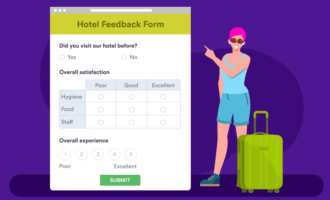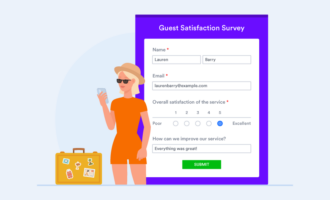When it comes to the fast-food market, things are constantly changing; unknown brands become huge franchises in an instant as consumers’ preferences change. So how does McDonald’s stay on top of the market year after year?
By knowing what people want.
McDonald’s focuses on four questions to discover how their customers view them:
- Which products are well received?
- What prices are customers willing to pay?
- What TV programs are consumers watching? What are they reading?
- Which restaurants do people visit the most?
Learning more about their customers from market research and focus groups enables McDonald’s to keep improving.
Like McDonald’s, we all want to improve our businesses. But not everyone has the time or resources to conduct extensive market research or focus groups. That’s where surveys come in. After all, the easiest way to discover what people really think about your business is to ask them.
Using the right questions can get you the answers you need to help your business reach its goals. Let’s look at the main types of survey questions you can ask and some examples.
Ask closed-ended questions: Have you visited our website before?
- Have you ever bought our products/services?
- Is our pricing clear?
- Do you think our products are effective?
Ask open-ended questions: What do you think of our website?
- What’s your overall impression of our website?
- What other products or features would you like us to add?
- Why did you choose us over our competitors?
Use rating scale questions: On a scale of 1–10…
- On a scale of 1 to 5, with 1 being the easiest and 5 being extremely difficult, how easy was it to use our website?
- On a scale of 1 to 7, with 1 being you’d never recommend it and 7 being you’d absolutely recommend it, how likely are you to recommend our products to a friend?
- On a scale of 1 to 10, with 10 being the best, 5 being OK, and 1 being the worst, how would you rate our customer service?
Ask multiple-choice questions: A, B, or C?
- Which feature do you use the most?
- Audience segmentation
- A/B testing
- Visitor analytics
- Other (short answer option)
- Compared to our competitors, our product is
- Worse
- Better
- About the same
- What country do you live in?
- United States
- Mexico
- Canada
- (and so on)
Also known as a yes-or-no question, a closed-ended question is ideal for getting basic information. This type of question is best for the beginning of a survey, since you can use it to segment your audience.
Here are some examples of closed-ended questions:
Closed-ended questions can give you an idea of how your participants view things and what they’ve experienced. But you don’t have to stop there. You can dig even deeper into people’s answers with open-ended questions.
An open-ended question, or a short answer option, gives people the chance to answer in their own words. You can use an open-ended question to get more details about a previous question and see why someone feels a certain way.
Open-ended questions can be about any subject. Here are some examples:
Short answer questions can be very effective, but making participants write paragraphs for every question will tire them out, so use open-ended questions only when needed. Thankfully, there are other types of questions you can use that aren’t as labor-intensive.
A rating scale can show how strongly your clients feel about something. It’s perfect for gauging how satisfied clients are with your business.
Just make sure you explain how your rating scale works. If you give a scale of 1 to 10 but don’t tell people if 10 is good or bad, then you won’t get accurate answers.
Here are some questions that use a rating scale:
A rating scale can be an effective tool for figuring out how people view your company.
There’s one more question type you can use. Multiple-choice questions can help you see how you compare to the competition.

Multiple-choice questions can help you compare various products or features you offer to see what people like more. You can also learn how you stack up to your competitors and their products. There’s even an opportunity to throw in a short answer question with a multiple choice one.
Here are some examples of multiple-choice questions:
Sprinkling in some multiple-choice questions can make your survey even better, but a multiple-choice question is just one option. There are lots of different survey questions you can use to gather the data you need.
Do you have time for a short survey?
Using the right kinds of survey questions can make it easier for your business to keep up in a constantly changing market.
Now that you can draft your survey, how are you going to get it to your audience? At Jotform, we can help you get your surveys up and running by offering secure ways for customers to express their thoughts. Try our forms for free today.






































































































Send Comment:
1 Comments:
More than a year ago
Being one of the most trusted Macdonald Survey service providers , Wes have landed in the ground to serve you with extraordinary upshots. We have been serving entire happily for many years, and over time we have learned how to win the hearts of our dedicated and esteemed clients.